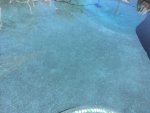- Nov 12, 2017
- 11,874
- Pool Size
- 12300
- Surface
- Plaster
- Chlorine
- Salt Water Generator
- SWG Type
- Pentair Intellichlor IC-40
Polishing and sanding may work, but will be very difficult and time consuming because at least an eighth inch layer of plaster will have to be removed in order to and remove the white discoloration and restore the original color. The thickness of typical plaster is about a half inch.
onBalance, when he tried to polish out the damage his crew caused to my plaster, my contractor got into the aggregate right quick, I want to say less than 1/8" down, and left a nasty blemish that neither looked nor felt like the surrounding plaster. It looked like very tiny pebbles, like miniature aggregate. Which is why I've been telling others here that plaster has a cream layer and aggregate layer below that. Do I have that wrong? If so, and it wasn't exposed aggregate I was feeling, what was that? It wasn't gunite (I don't think), because they didn't polish very deep at all, but it definitely wasn't plaster alone, either.



